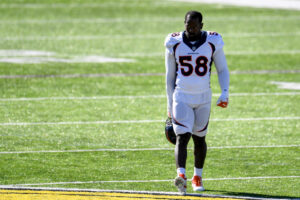A pair of Denver police officers handcuffed an innocent man in his own apartment last year after mistakenly identifying him as a suspect who broke a window, even though he did not match the description of the wanted man.
One of the officers, Cpl. Robert Smith, will lose four days of pay for detaining the man in the June 2020 incident and needlessly escalating the situation until it spun out of control, according to an Aug. 26 disciplinary letter obtained by The Denver Post through a public records request.
“Despite the glaring differences in (the man’s) appearance and the eyewitness’s description of the suspect, Cpl. Smith chose to be accusatory and confrontational,” Chief Deputy Director of Public Safety Mary Dulacki wrote in the letter. “This approach is all the more disturbing in the context of the social events of the time where police contact with suspects, particularly BIPOC suspects, was under intense scrutiny following the death of George Floyd.” (BIPOC is an acronym for Black, Indigenous and people of color.)
At approximately 8:30 p.m. on June 9, 2020 — one week after massive protests of police brutality began in downtown Denver — a person called 911 to report that a man threw a rock and broke a window at a medical imaging business at Colfax Avenue and Ogden Street. The witness described the suspect as a white man in his 20s wearing a white baseball cap, a black-and-red plaid long-sleeve shirt, blue jeans and white shoes.
Smith and an officer he was training responded, and while looking at the scene saw a man walk into a nearby apartment building. Smith said that the man appeared to be wearing the clothes in the description but hesitated because the man was Black, though Smith said he was light-skinned.
Smith and the trainee officer knocked on the apartment building’s door and spoke to the manager about the man they saw enter the building and gave him a description. The manager walked the officers through the empty common areas. The trainee officer suggested that they knock on the door of a man the manager mentioned in an earlier conversation.
The manager knocked on the door and the man who lived there answered wearing a light-colored baseball cap, a solid red shirt, red pants, a red tie and black shoes. The man, who is identified in the disciplinary letter only by his initials, confirmed that he had just walked into the building.
Smith immediately accused the man of breaking the window then going into the apartment to change his clothes, which the man denied. The man declined to show the officers his identification, though his name was on his apartment door, and asked if they had any reasonable suspicion that he committed a crime. The man said video surveillance at the 7-Eleven he just visited would prove he’d been wearing the same clothes he wore when he answered the door, which did not match the clothes worn by the described suspect.
The man told officers he was going into his apartment to get a video camera to record the interaction. He told the officers that they didn’t have permission to come inside, but the officers followed him inside anyway.
As the man shouted that the officers didn’t have a right to come in, the officers grabbed him and forced him to the door where they were joined by two other officers, according to the letter.
“(The man) continued to loudly protest his detention, saying several times he was going to call the police,” the letter states. “The officers repeatedly responded, ‘We are the police.’”
The officers forcibly handcuffed the man, scraping one of his wrists. Two officers went to check the surveillance video at the 7-Eleven, which verified that the man wasn’t lying and had never worn clothes that met the suspect’s description. The man was then released.
When internal affairs investigators asked Smith why he contacted the man even though he didn’t meet the description, Smith said crime witnesses are rarely 100% correct on a description. He also said he contacted the man because “the area is predominantly associated with the Crip gang” who wear blue and thus it was odd to see someone wear red, which is associated with Bloods.
Smith admitted that he made mistakes in the interaction and acted in an “overbearing manner.” He said he understood why the man was outraged.
Dulacki found that Smith did not have the legal right to demand to see the man’s identification and that the corporal chose to escalate the situation instead of defusing it. Smith’s choices “degraded the department’s legitimacy and trust with the community,” she wrote.
The trainee officer did not face any discipline in connection to the incident because he was following the direction of his training officer, Dulacki said.



















